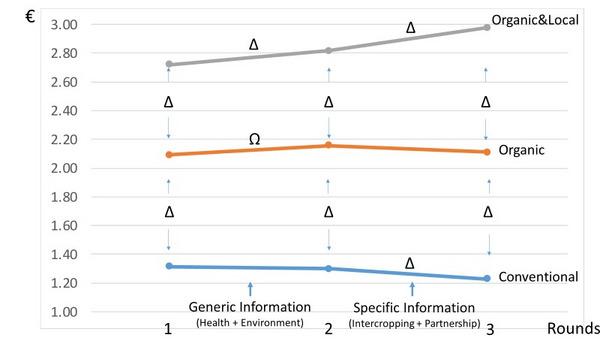A laboratory study was organized in France to explore consumer reactions to information about lentils, a legume, which is sustainable and recommended by nutritionists and environmentalists (see the laboratory context in figure 1). More specifically, we examined the effect that information has on consumer willingness to pay for lentils bearing different product labels.
Study participants were first asked to indicate their willingness to pay for lentils with different characteristics: conventional, organic and organic and local. The results show that labelling had a strong influence on initial willingness to pay (see average willingness to pay in round #1 in figure 2).
In the laboratory, participants were then given generic messages promoting lentils in general. One message described the nutritional benefits coming from lentil consumption. The other one focused on environmental benefits related to lentil cultivation and how adding lentils to crop rotations can provide more nitrogen for the following crop. Results showed that the additional information had a weak but significant increase in willingness to pay for the lentils with the organic label and for the lentils with the organic and local production labels (see changes in average willingness to pay between rounds #1 and #2 in figure 2). The information had no significant effect for the conventional lentils without any production labels.
Finally, participants were given additional information about "innovative" agricultural practices (e.g., intercropping, organic and local production, and producer partnerships) used to produce the lentils coming from the specific brand with organic and local labels. Based on this specific information related to a brand, there was a significant increase in willingness to pay for the lentils with organic and local production labels (see changes in average willingness to pay between rounds #2 and #3 in figure 2).
We thus conclude that providing information via nutritional recommendations/advertising about the benefits and production methods that are used to produce lentils while also further developing legume-labelling systems could act synergistically to drive changes in consumer choices.
To achieve this, information campaigns towards consumers could be launched to promote legume consumption, even if the short-term effects on legume sales may be very limited or null. Furthermore, labelling systems to include information about longer crop rotations could be developed, and the use of intercropping could help promote increased crop diversification. This could either be done by focusing on organic, which often uses longer rotations. Creating a specific label for crop diversification could be envisaged but it is likely to have a very limited impact, as demonstrated in our study and also due to the abundance of food labels that already exist.
However, given the limited impact that specific information on crop diversification has on consumers’ willingness to pay, policymakers should focus on other tools to boost crop diversification. These alternative instruments should target farmers’ incentives to adopt crop diversification.
Further information
Download
The article in Sustainability 2021, 13(6), 3408
*Notes for figure 2: Notes: Average over 127 participants. The null hypothesis of no difference is rejected, with Ω denoting a significant difference at 5% and Δ denoting a significant difference at 1%, as tested by the Wilcoxon test for comparing paired sample willingness to pay. For a given round, a significant difference between the willingness to pay for different packets is indicated with Ω or Δ between vertical arrows. For a given packet, the significant impact of information/message between two successive rounds is indicated with Ω or Δ on the segment linked to the packet. Source: Stephan Marette.




 tap and then scroll down to the Add to Home Screen command.
tap and then scroll down to the Add to Home Screen command.
Disqus
In order to use the comment function, you must register with the third-party provider "Disqus".
When you activate this function, your browser establishes a direct connection with the servers of the third-party provider. We would like to point out that data is transmitted to the third-party provider after activation, and the latter may set cookies that can also be used for analysis and marketing purposes. For more information, please refer to our privacy policy.
Activate